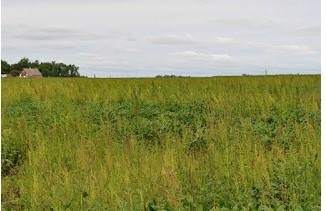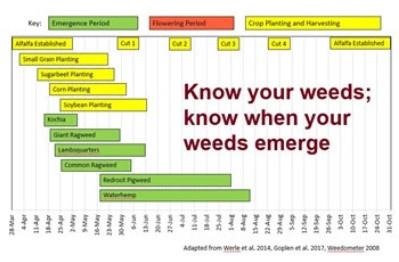By Phyllis Bongard
With increasing herbicide resistance and a decrease in effective management tools, weed management will continue to become more complicated. Drs. Tom Peters, Extension sugarbeet agronomist and weed scientist, and Debalin Sarangi, Extension weed scientist, joined Extension Educators Ryan Miller, Dave Nicolai and Jared Goplen for a wide-ranging discussion on effective weed management strategies in the February 2 session of Strategic Farming: Let’s talk crops!

Waterhemp in Minnesota field.
Weed management strategies
Know your weeds
Weed management is all about fundamentals, according to Peters. Learning about the characteristics that makes one weed different from another is crucial for managing them effectively.
Identification
Weed identification is not easy, since what you’re looking at in the field may be different from what you might see in a photo or in a greenhouse. Don’t be afraid to ask for help from Extension, your crop consultant or service provider. You can’t control the weeds if you’re not sure what they are, reinforces Peters.
Extension’s weed identification website is a resource you might find helpful.
Life cycle and emergence patterns

Figure 1. Timeline of weed emergence patterns in relation
to crop planting in a growing season.
Different weeds germinate and emerge at a variety of times during the growing season (Figure 1). Giant ragweed, for example, is one of the earliest emerging weeds with 90% emerged by June 1, states Goplen. Waterhemp, on the other hand, has an extended emergence period starting roughly in mid-May and continuing into August. Knowing your weeds’ emergence patterns will help when selecting tools for an effective management program.
Reproduction characteristics
What kind of flowers does the weed have? If they’re imperfect – meaning male and female flowers are on different plants – then that weed may display more diversity. It might show up as differences in how the weed looks in the field or in other characteristics, such as emergence timing or even herbicide resistance. Waterhemp and kochia are examples of weeds that have imperfect flowers.
Some weeds are more prolific seed producers than others. Giant ragweed, for example, has been found to produce from 1,800 to 10,000 seeds/plant, while waterhemp can average over 350,000 seeds/plant. If waterhemp is allowed to go to seed, you’re going to get hundreds of thousands if not millions of seeds, so the penalty for lack of weed control is tremendous, says Peters.
Seedbank viability
Likewise, weeds differ in how long seeds are viable. Goplen’s research showed that giant ragweed’s seedbank could be depleted 96% in two years. Common lambsquarters seeds, on the other hand, can be viable for decades.
In the case of waterhemp, seeds are viable on average for four years. Because it is such a prolific seed producer, strong, integrative weed control programs across multiple crops for consecutive years are essential for reducing its seedbank.
Herbicide carryover
Given the dry 2021 growing season, will herbicide carryover be a concern in 2022? Herbicide labels give some guidance on potential injury to follow crops, but herbicide chemistry, environmental conditions, and your soil type will dictate any concerns.
Herbicide chemistry
The herbicide’s chemical structure determines how tightly it is bound to the soil and how water soluble it is. A herbicide that is highly bound to soil particles will be in the soil longer than a herbicide that’s more available in the water solution and susceptible to breakdown by soil microbes.
Moisture and temperature
In a dry year, there will be more herbicide residual in the soil than in a wet year. Peters’ rule of thumb is to add the rainfall totals from June 1 to September 1. If that total is less than 6 inches, then take a good look at the products you used in 2021, the crops you’re planning to plant, and then investigate those carryover concerns.
The optimum temperature range for herbicide degradation is between 70 and 85 degrees F. Last fall’s rains were welcome at the end of a dry season, but may not have contributed much to herbicide degradation, since temperatures were below the optimum range for microbial activity.
Soils
Soil characteristics, such as pH, soil organic matter, and soil type, can also influence carryover potential.
Product availability
Peters’ advice is to talk to your retailer about product availability. Let them know what you intend to use and plan an integrated approach that includes soil-applied residual herbicides. To buffer against any shortages of traited herbicide packages, look at traditional postemergence herbicide options, too.
Herbicide resistance
Minnesota herbicide resistance screening
Sarangi’s team has been screening waterhemp populations for resistance to several postemergence herbicides. He is considering a population resistant when more than 40% of its individuals can survive three times the normal herbicide application rate. Between 2020 and 2021, they collected 150 samples across Minnesota. Results from 2020, which included 21 waterhemp populations, were shared during the webinar:
- 100% of the populations were resistant to ALS (Group 2) herbicides (ex. Raptor)
- 66% were resistant to glyphosate (Group 9) (Roundup)
- 14% were resistant to atrazine (Group 5)
- 14% were resistant to fomesafen (Group 14 - PPO) (ex. Flexstar)
- 5% were resistant to mesotrione (Group 27 – HPPD) (ex. Callisto)
None of the populations that were evaluated showed resistance to glufosinate (Liberty), 2,4-D, or dicamba. However, Sarangi is concerned because there were individuals within those populations that survived 2,4-D and dicamba exposure.
Resistance management
An integrated approach is key for managing herbicide resistance. It includes tools such as using soil-applied residual herbicides, tillage, and crop rotation, diversifying herbicide selection, and tolerating no weed seed production.
Peters and Goplen encourage growers to start clean in the spring with tillage or a burndown application to control those early emerging weeds. Then put together a balanced program that includes soil-applied residual preemergence (PRE) herbicides.
Layering soil-residual PREs for corn and soybean is a good option for controlling late-emerging weeds like waterhemp. By tank mixing a Group 15 herbicide with your postemergence treatments, the control window is extended. For more information, see Managing waterhemp with layered residual herbicides.
Interrow cultivation during the season also has value in controlling late-emerging weeds.
Finally, manage the weed seed bank. Don’t let up on control, since even a small surviving percentage of a huge seed bank can cause major issues.
Source : umn.edu